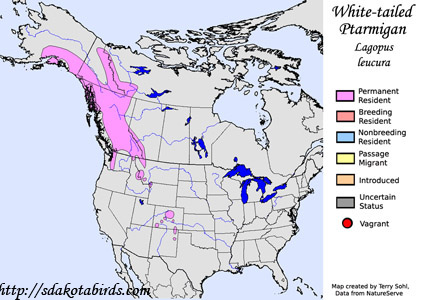| Length: 12 inches | Wingspan: 22 inches | Seasonality: Non-resident in South Dakota |
| ID Keys: All white in winter plumage. In summer, females brownish and speckled all over, males brownish above, white below. | ||
 The
White-tailed Ptarmigan is the smallest ptarmigan and the smallest of all
grouse species that live in North America. They rely on colder
habitats, but unlike Rock Ptarmigan
and Willow Ptarmigan that are almost
exclusively found in Canada and Alaska, the White-tailed Ptarmigan's range
also extends to high-elevation alpine areas of the Rocky Mountains in the
western United States. As with the other ptarmigan species, the
plumage of the White-tailed Ptarmigan turns completely white in the winter.
During the summer, the female is brownish with speckling and barring.
The male has brownish upperparts in the summer, but retains white on the
belly.
The
White-tailed Ptarmigan is the smallest ptarmigan and the smallest of all
grouse species that live in North America. They rely on colder
habitats, but unlike Rock Ptarmigan
and Willow Ptarmigan that are almost
exclusively found in Canada and Alaska, the White-tailed Ptarmigan's range
also extends to high-elevation alpine areas of the Rocky Mountains in the
western United States. As with the other ptarmigan species, the
plumage of the White-tailed Ptarmigan turns completely white in the winter.
During the summer, the female is brownish with speckling and barring.
The male has brownish upperparts in the summer, but retains white on the
belly.
Habitat: In the summer breeding season, they are found in alpine areas above the treeline, either on alpine meadows or rocky slopes with scattered short vegetation. In the winter they move to lower elevations where willows and other plants protrude from the snowpack.
Diet: Feeds almost exclusively on plant material, preferring to feed on buds, fresh twigs, and the leaves of willow trees, but they will also consume similar material from other trees and shrubs. The young feed heavily on insects after hatching, but also soon switch to a vegetarian diet.
Behavior: White-tailed Ptarmigan feed by walking along the ground, using their bill to strip and consume vegetation from shrubs and trees. They are usually gregarious outside of the summer breeding season, foraging in small flocks.
Nesting: The nest of a White-tailed Ptarmigan is a shallow depression lined with plants and feathers, placed on the ground in an area with some protection such as rocks or dwarf willows. The female alone incubates the eggs. Within a few hours after the young hatch, they leave the nest, with the female tending to them, but the young find their own food.
Song: The displaying male White-tailed Ptarmigan has a rapid series of clucking notes.
Migration: Considered to be a permanent resident throughout their range, but there are short-distance elevational movements, with birds moving to lower elevations for the winter.
Interactive eBird map: Click here to access an interactive eBird map of White-tailed Ptarmigan sightings
Similar Species: Willow Ptarmigan, Rock Ptarmigan
Conservation Status: Populations of White-tailed Ptarmigan may be decreasing in some areas, but they still are widespread and common in much of their range. The IUCN lists the White-tailed Ptarmigan as a species of "Least Concern".
Further Information: 1) BirdWeb.org - White-tailed Ptarmigan
2) BiologicalDiversity.org - White-tailed Ptarmigan
3) USGS Bird InfoCenter - White-tailed Ptarmigan
Photo Information: Photo taken by U.S. Fish & Wildlife Mountain-Prairie - Licensed under Creative Commons Attribution 2.0 Generic License.
| Click below for a higher-resolution map |
 |
| South Dakota Status: Non-resident in South Dakota |
Additional White-tailed Ptarmigan Photos (coming soon!)
